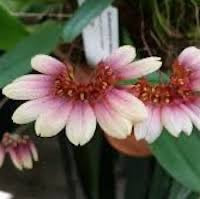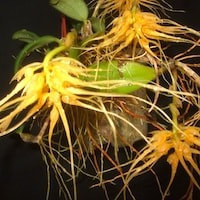MOR9- Men's Oriental 9 - The merchant of allspice
|
Native Singaporean Orchid notes: Angraecum Compactum
Angraecum compactum, native to Madagascar, is renowned for its fragrant nocturnal flowers emitting a citrusy scent with spicy undertones. Belonging to the Orchidaceae family, it thrives in Madagascar's highlands and eastern regions, typically growing epiphytically on trees and rocks. Used in the Oriental 9 (Men) Team Building Perfume Workshop, its captivating fragrance adds depth to perfumes. Conservation efforts are crucial to sustainably harness its aromatic properties and protect its habitat.
|
Therapeutic Orchid notes:
|
Anacamptis pyramidalis
Anacamptis pyramidalis, commonly known as the Pyramidal Orchid, is prized for its role in producing Salep, a traditional beverage and health tonic in Turkey and Iran. Belonging to the Orchidaceae family, it is native to Europe, North Africa, and the Middle East. Salep is made from its tubers, which are dried and ground. This orchid stands out due to its high mucin content (44.72%), essential for Salep's demulcent properties. Moreover, it produces phytoalexins like orchinol and p-hydroxybenzyl alcohol, known for their skin whitening effects by inhibiting melanin production. Additionally, it exhibits antioxidant properties, adding to its medicinal and cosmetic value. |
|
Bulbophyllum flabellum-veneris Syn. Bulbophyllum lepidum (Blume) J.J. Sm., Cirrhopetalum lepidum (Blume) Schltr.
Bulbophyllum flabellum-veneris, also known as Bulbophyllum lepidum and Cirrhopetalum lepidum, is a unique orchid found across Southeast Asia, including Thailand, Malaysia, Indonesia, and Borneo. It blooms with olive-green flowers year-round, peaking during the rainy seasons influenced by monsoons. In Thailand, it has traditional medicinal uses: the pseudobulb treats oedema with its diuretic properties, and the whole plant addresses liver dysfunction, believed to have hepatoprotective benefits. Conservation efforts are crucial due to threats like habitat loss and climate change, which endanger its natural habitats and survival in the wild. |
|
Bulbophyllum vaginatum
Bulbophyllum vaginatum, also known as Cirrhopetalum vaginatum, is a common orchid found in Southeast Asia, thriving on Rain Trees in Singapore and various other trees in Malaysia. Its flowering is triggered by sudden temperature drops after rainstorms. This orchid is renowned for its rich phytochemical profile, including unique compounds like phenanthro(4,3-b)furan, not found in other orchids. Researchers are exploring its potential antitumor properties, suggesting it could lead to new cancer treatments. Traditionally, it has been used in Malaya for earaches, in China and Nepal for respiratory infections and fractures, and in Myanmar as a hair tonic and shampoo. Further scientific studies are needed to confirm these traditional uses, while conservation efforts are crucial to safeguard its habitats. |
|
Calanthe masuca (D. Don) Lindl. Syn. Calanthe sylvatica (Thou.) Lindl.
Calanthe masuca, also known as Calanthe sylvatica, is a versatile orchid species found in China, Bhutan, Myanmar, and Nepal. It is recognized by various Chinese names like Changjuxiaji Lan and Zihuaxiaji Lan, and in Myanmar and Nepal, it's known as Thazin gyi myo kywe and Pakha phul respectively. This orchid is valued in traditional medicine for its analgesic and anti-inflammatory properties, used to relieve pain, reduce inflammation, and treat conditions like nosebleeds and dislocated bones. Calanthe masuca also holds historical significance as one of the first orchids used in hybridization, a practice pivotal in creating diverse orchid hybrids in horticulture. Conservation efforts are crucial to safeguard its habitats and cultural heritage, ensuring its continued presence in the wild. |
|
Coelogyne flaccida Lindl.
Coelogyne flaccida, known as chestnut scales pearl shell orchid, is found in China and Nepal, recognized locally as Lilinbeimu Lan and Guishangye in Chinese, and Thur gava in Nepali. In Chinese medicine, it's referred to as Jidatui. This orchid contains compounds like flaccidin and sofaccidin, which contribute to its medicinal properties. Traditionally, it's used to clear heat, alleviate dryness, and enhance body fluid production. In Nepal, it treats headaches and indigestion. Conservation efforts are crucial due to threats like habitat loss and over-collection, highlighting the need for sustainable practices and environmental awareness. |
|
Corymborkis veratrifolia (Reinw.) Blume
Corymborkis veratrifolia, known as Guanhua Lan in Chinese and Kayu Hok in aboriginal Semang language, is an orchid species noted for its alkaloid content. Alkaloids are bioactive compounds with diverse medicinal properties, although specific details about those present in this orchid are not specified. Traditionally, it has been used in India for inducing vomiting with its leaf juice and in the British Solomon Islands to treat foot cuts. Conservation efforts are crucial due to threats like habitat loss and over-collection, emphasizing the need for sustainable practices and environmental awareness to protect this orchid species. |
Other scent note
Japanese nutmeg, bergamot, peppercorn, ginger, aquatic notes, peppermint, vetiver, labdanum, and frankincense
Scentopia Library Reference ingredient
Clove- Sir Raffles Collection - Check details at Scentopia's scent library
Download the guided mediation that works best with this Orchid fragrance oil
| men_oriental_essential_oil_orchi_00009.mp3 | |
| File Size: | 215749 kb |
| File Type: | mp3 |






